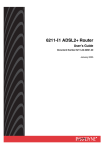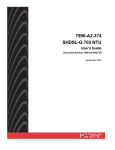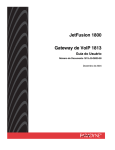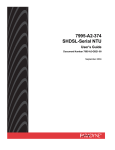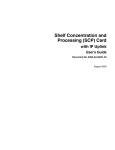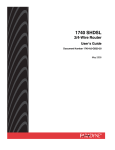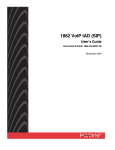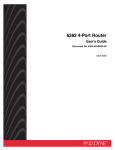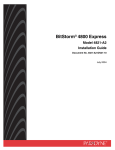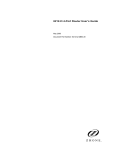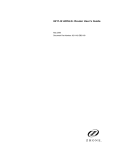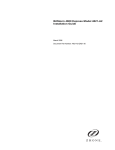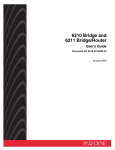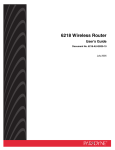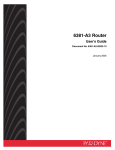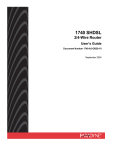Download Paradyne 6212-I1 User's Manual
Transcript
6212-I1 4-Port Router User’s Guide Document No. 6212-A2-GB23-00 September 2005 Copyright 2005 Paradyne Corporation. All rights reserved. Printed in U.S.A. Notice This publication is protected by federal copyright law. No part of this publication may be copied or distributed, transmitted, transcribed, stored in a retrieval system, or translated into any human or computer language in any form or by any means, electronic, mechanical, magnetic, manual or otherwise, or disclosed to third parties without the express written permission of Paradyne Corporation, 8545 126th Ave. N., Largo, FL 33773. Paradyne Corporation makes no representation or warranties with respect to the contents hereof and specifically disclaims any implied warranties of merchantability or fitness for a particular purpose. Further, Paradyne Corporation reserves the right to revise this publication and to make changes from time to time in the contents hereof without obligation of Paradyne Corporation to notify any person of such revision or changes. Changes and enhancements to the product and to the information herein will be documented and issued as a new release to this manual. Warranty, Sales, Service, and Training Information Contact your local sales representative, service representative, or distributor directly for any help needed. For additional information concerning warranty, sales, service, repair, installation, documentation, training, distributor locations, or Paradyne worldwide office locations, use one of the following methods: Internet: Visit the Paradyne World Wide Web site at www.paradyne.com. (Be sure to register your warranty at www.paradyne.com/warranty.) Telephone: Call our automated system to receive current information by fax or to speak with a company representative. — Within the U.S.A., call 1-800-795-8004 — Outside the U.S.A., call 1-727-530-2340 Document Feedback We welcome your comments and suggestions about this document. Please mail them to Technical Publications, Paradyne Corporation, 8545 126th Ave. N., Largo, FL 33773, or send e-mail to [email protected]. Include the number and title of this document in your correspondence. Please include your name and phone number if you are willing to provide additional clarification. Trademarks Acculink, ADSL/R, Bitstorm, Comsphere, DSL the Easy Way, ETC, Etherloop, FrameSaver, GranDSLAM, GrandVIEW, Hotwire, the Hotwire logo, iMarc, Jetstream, MVL, NextEDGE, Net to Net Technologies, OpenLane, Paradyne, the Paradyne logo, Paradyne Credit Corp., the Paradyne Credit Corp. logo, Performance Wizard, ReachDSL, StormPort, TruePut are registered trademarks of Paradyne Corporation. Connect to Success, Hotwire Connected, JetFusion, JetVision, MicroBurst, PacketSurfer, Quick Channel, Reverse Gateway, Spectrum Manager, and StormTracker are trademarks of Paradyne Corporation. All other products or services mentioned herein are the trademarks, service marks, registered trademarks, or registered service marks of their respective owners. A September 2005 6212-A2-GB23-00 ! Important Safety Instructions 1. Read and follow all warning notices and instructions marked on the product or included in the manual. 2. Slots and openings in the cabinet are provided for ventilation. To ensure reliable operation of the product and to protect it from overheating, these slots and openings must not be blocked or covered. 3. Do not allow anything to rest on the power cord and do not locate the product where persons will walk on the power cord. 4. Do not attempt to service this product yourself, as opening or removing covers may expose you to dangerous high voltage points or other risks. Refer all servicing to qualified service personnel. 5. General purpose cables are used with this product for connection to the network. Special cables, which may be required by the regulatory inspection authority for the installation site, are the responsibility of the customer. Use a UL Listed, CSA certified, minimum No. 24 AWG line cord for connection to the Digital Subscriber Line (DSL) network. 6. When installed in the final configuration, the product must comply with the applicable Safety Standards and regulatory requirements of the country in which it is installed. If necessary, consult with the appropriate regulatory agencies and inspection authorities to ensure compliance. 7. A rare phenomenon can create a voltage potential between the earth grounds of two or more buildings. If products installed in separate buildings are interconnected, the voltage potential may cause a hazardous condition. Consult a qualified electrical consultant to determine whether or not this phenomenon exists and, if necessary, implement corrective action prior to interconnecting the products. 8. Input power to this product must be provided by one of the following: (1) a UL Listed/CSA certified power source with a Class 2 or Limited Power Source (LPS) output for use in North America, or (2) a certified transformer, with a Safety Extra Low Voltage (SELV) output having a maximum of 240 VA available, for use in the country of installation. 9. In addition, since the equipment is to be used with telecommunications circuits, take the following precautions: — Never install telephone wiring during a lightning storm. — Never install telephone jacks in wet locations unless the jack is specifically designed for wet locations. — Never touch uninsulated telephone wires or terminals unless the telephone line has been disconnected at the network interface. — Use caution when installing or modifying telephone lines. — Avoid using a telephone (other than a cordless type) during an electrical storm. There may be a remote risk of electric shock from lightning. — Do not use the telephone to report a gas leak in the vicinity of the leak. CE Marking When the product is marked with the CE mark on the equipment label, a supporting Declaration of Conformity may be downloaded from the Paradyne World Wide Web site at www.paradyne.com. Select Library → Technical Manuals → CE Declarations of Conformity. FCC Part 15 Declaration An FCC Declaration of Conformity may be downloaded from the Paradyne World Wide Web site at www.paradyne.com. Select Support -> Technical Manuals -> Declarations of Conformity. This device complies with Part 15 of the FCC Rules. Operation is subject to the following two conditions: (1) this device may not cause harmful interference, and (2) this device must accept any interference received, including interference that may cause undesired operation. The authority to operate this equipment is conditioned by the requirement that no modifications will be made to the equipment unless the changes or modifications are expressly approved by the responsible party. 6212-A2-GB23-00 September 2005 B This equipment has been tested and found to comply with the limits for a Class B digital device, pursuant to Part 15 of the FCC Rules. These limits are designed to provide reasonable protection against harmful interference in a residential installation. This equipment generates, uses, and can radiate radio frequency energy and, if not installed and used in accordance with the instructions, may cause harmful interference to radio communications. However, there is no guarantee that interference will not occur in a particular installation. If this equipment does cause harmful interference to radio or television reception, which can be determined by turning the equipment off and on, the user is encouraged to try to correct the interference by one or more of the following measures: Reorient or relocate the receiving antenna. Increase the separation between the equipment and receiver. Connect the equipment into an outlet on a circuit different from that to which the receiver is connected. Consult the dealer or an experienced radio/TV technician for help. Notice to Users of the United States Telephone Network The following notice applies to versions of the modem that have been FCC Part 68 approved. This equipment complies with Part 68 of the FCC rules and the requirements adopted by the Administrative Council for Terminal Attachment (ACTA). On the bottom side of this equipment is a label that contains, among other information, a product identifier in the format US:AAAEQ##TXXXX. If requested, this number must be provided to the Telephone Company. This equipment is intended to connect to the Public Switched Telephone Network through a Universal Service Order Code (USOC) type RJ11C jack. A plug and jack used to connect this equipment to the premises wiring and telephone network must comply with the applicable FCC Part 68 rules and requirements adopted by the ACTA. A compliant telephone cord and modular plug is provided with this product. It has been designed to be connected to a compatible modular jack that is also compliant. The Ringer Equivalence Number (or REN) is used to determine the number of devices that may be connected to a telephone line. Excessive RENs on a telephone line may result in the devices not ringing in response to an incoming call. In most but not all areas, the sum of RENs should not exceed five (5.0). To be certain of the number of devices that may be connected to a line, as determined by the total RENs, contact the local Telephone Company. The REN for this product is part of the product identifier that has the format US:AAAEQ##TXXXX. The digits represented by ## are the REN without a decimal point. For example, 03 represents a REN of 0.3. If the modem causes harm to the telephone network, the Telephone Company will notify you in advance that temporary discontinuance of service may be required. But if advance notice is not practical, the Telephone Company will notify the customer as soon as possible. Also, you will be advised of your right to file a complaint with the FCC if you believe it is necessary. The Telephone Company may make changes in its facilities, equipment, operations or procedures that could affect the operation of the equipment. If this happens, the Telephone Company will provide advance notice in order for you to make necessary modifications to maintain uninterrupted service. If trouble is experienced with the modem, refer to the repair and warranty information in this document. If the equipment is causing harm to the telephone network, the Telephone Company may request that you disconnect the equipment until the problem is resolved. The user may make no repairs to the equipment. Connection to party line service is subject to state tariffs. Contact the state public utility commission, public service commission or corporation commission for information. If the site has specially wired alarm equipment connected to the telephone line, ensure the installation of the modem does not disable the alarm equipment. If you have questions about what will disable alarm equipment, consult your Telephone Company or a qualified installer. C September 2005 6212-A2-GB23-00 Notice to Users of the Canadian Telephone Network NOTICE: This equipment meets the applicable Industry Canada Terminal Equipment Technical Specifications. This is confirmed by the registration number. The abbreviation IC before the registration number signifies that registration was performed based on a Declaration of Conformity indicating that Industry Canada technical specifications were met. It does not imply that Industry Canada approved the equipment. NOTICE: The Ringer Equivalence Number (REN) for this terminal equipment is labeled on the equipment. The REN assigned to each terminal equipment provides an indication of the maximum number of terminals allowed to be connected to a telephone interface. The termination on an interface may consist of any combination of devices subject only to the requirement that the sum of the Ringer Equivalence Numbers of all the devices does not exceed five. If your equipment is in need of repair, contact your local sales representative, service representative, or distributor directly. ! CANADA - EMI NOTICE: This Class B digital apparatus meets all requirements of the Canadian interference-causing equipment regulations. Cet appareil numérique de la classe B respecte toutes les exigences du règlement sur le matérial brouilleur du Canada. Japan Notices This is a Class B product based on the standard of the Voluntary Control Council for Interference from Information Technology Equipment (VCCI). If this is used near a radio or television receiver in a domestic environment, it may cause radio interference. Install and use the equipment according to the instruction manual. 6212-A2-GB23-00 September 2005 D E September 2005 6212-A2-GB23-00 Contents About This Guide 1 2 Document Purpose and Intended Audience . . . . . . . . . . . . . . . . . . . . v Document Summary . . . . . . . . . . . . . . . . . . . . . . . . . . . . . . . . . . . . . . v Product-Related Documents . . . . . . . . . . . . . . . . . . . . . . . . . . . . . . . . vi Introduction . . . . . . . . . . . . . . . . . . . . . . . . . . . . . . . . . . . . . . . . . . . . . 1-1 Features . . . . . . . . . . . . . . . . . . . . . . . . . . . . . . . . . . . . . . . . . . . . . . . . 1-1 System Requirements . . . . . . . . . . . . . . . . . . . . . . . . . . . . . . . . . . . . . 1-1 Parts List . . . . . . . . . . . . . . . . . . . . . . . . . . . . . . . . . . . . . . . . . . . . . . . 1-2 Front Panel. . . . . . . . . . . . . . . . . . . . . . . . . . . . . . . . . . . . . . . . . . . . . . 1-3 Rear Panel . . . . . . . . . . . . . . . . . . . . . . . . . . . . . . . . . . . . . . . . . . . . . . 1-4 Introduction Hardware Installation and PC Setup Overview . . . . . . . . . . . . . . . . . . . . . . . . . . . . . . . . . . . . . . . . . . . . . . . 2-1 Connecting the Hardware . . . . . . . . . . . . . . . . . . . . . . . . . . . . . . . . . . 2-2 Configuring Your Computer . . . . . . . . . . . . . . . . . . . . . . . . . . . . . . . . . 2-4 Windows XP . . . . . . . . . . . . . . . . . . . . . . . . . . . . . . . . . . . . . . . . . 2-5 Windows 2000 . . . . . . . . . . . . . . . . . . . . . . . . . . . . . . . . . . . . . . . . 2-7 Windows ME . . . . . . . . . . . . . . . . . . . . . . . . . . . . . . . . . . . . . . . . . 2-7 Windows 95 and Windows 98 . . . . . . . . . . . . . . . . . . . . . . . . . . . . 2-8 Windows NT 4.0 . . . . . . . . . . . . . . . . . . . . . . . . . . . . . . . . . . . . . . 2-9 3 Logging in to Your Router . . . . . . . . . . . . . . . . . . . . . . . . . . . . . . . . . . 2-10 Device Information 6212-A2-GB23-00 Status Summary. . . . . . . . . . . . . . . . . . . . . . . . . . . . . . . . . . . . . . . . . . 3-1 WAN. . . . . . . . . . . . . . . . . . . . . . . . . . . . . . . . . . . . . . . . . . . . . . . . . . . 3-2 LAN Statistics . . . . . . . . . . . . . . . . . . . . . . . . . . . . . . . . . . . . . . . . . . . . 3-3 WAN Statistics . . . . . . . . . . . . . . . . . . . . . . . . . . . . . . . . . . . . . . . . . . . 3-3 ATM Statistics . . . . . . . . . . . . . . . . . . . . . . . . . . . . . . . . . . . . . . . . . . . 3-4 ADSL Statistics . . . . . . . . . . . . . . . . . . . . . . . . . . . . . . . . . . . . . . . . . . 3-4 ADSL BER Test . . . . . . . . . . . . . . . . . . . . . . . . . . . . . . . . . . . . . . . . . . 3-5 Route . . . . . . . . . . . . . . . . . . . . . . . . . . . . . . . . . . . . . . . . . . . . . . . . . . 3-6 September 2005 i Contents 4 5 ARP . . . . . . . . . . . . . . . . . . . . . . . . . . . . . . . . . . . . . . . . . . . . . . . . . . . 3-6 Quick Setup with Auto-Connect Enabled . . . . . . . . . . . . . . . . . . . . . . . 4-1 Quick Setup with Auto-Connect Disabled . . . . . . . . . . . . . . . . . . . . . . 4-3 Quick Setup Advanced Setup ii WAN. . . . . . . . . . . . . . . . . . . . . . . . . . . . . . . . . . . . . . . . . . . . . . . . . . . 5-1 Add Function – ATM PVC Configuration . . . . . . . . . . . . . . . . . . . . 5-2 Connection Type Screen . . . . . . . . . . . . . . . . . . . . . . . . . . . . . . . . 5-3 WAN Setup - Summary . . . . . . . . . . . . . . . . . . . . . . . . . . . . . . . . . 5-4 Remove Function. . . . . . . . . . . . . . . . . . . . . . . . . . . . . . . . . . . . . . 5-4 Finish Function . . . . . . . . . . . . . . . . . . . . . . . . . . . . . . . . . . . . . . . 5-5 Local Area Network (LAN) Setup . . . . . . . . . . . . . . . . . . . . . . . . . . . . . 5-5 NAT . . . . . . . . . . . . . . . . . . . . . . . . . . . . . . . . . . . . . . . . . . . . . . . . . . . 5-6 Virtual Servers . . . . . . . . . . . . . . . . . . . . . . . . . . . . . . . . . . . . . . . . 5-6 Port Triggering . . . . . . . . . . . . . . . . . . . . . . . . . . . . . . . . . . . . . . . . . . . 5-7 DMZ Host . . . . . . . . . . . . . . . . . . . . . . . . . . . . . . . . . . . . . . . . . . . . . . . 5-9 Firewall. . . . . . . . . . . . . . . . . . . . . . . . . . . . . . . . . . . . . . . . . . . . . . . . . 5-9 IP Filtering – Outgoing . . . . . . . . . . . . . . . . . . . . . . . . . . . . . . . . . . 5-9 IP Filtering – Incoming . . . . . . . . . . . . . . . . . . . . . . . . . . . . . . . . . . 5-11 Firewall – MAC Filtering. . . . . . . . . . . . . . . . . . . . . . . . . . . . . . . . . 5-12 Parental Control. . . . . . . . . . . . . . . . . . . . . . . . . . . . . . . . . . . . . . . 5-14 Port Mapping . . . . . . . . . . . . . . . . . . . . . . . . . . . . . . . . . . . . . . . . . . . . 5-15 Quality of Service . . . . . . . . . . . . . . . . . . . . . . . . . . . . . . . . . . . . . . . . . 5-16 Routing – Default Gateway . . . . . . . . . . . . . . . . . . . . . . . . . . . . . . . . . 5-17 Routing – Static Route . . . . . . . . . . . . . . . . . . . . . . . . . . . . . . . . . . . . . 5-18 Routing – RIP. . . . . . . . . . . . . . . . . . . . . . . . . . . . . . . . . . . . . . . . . . . . 5-19 DNS Server . . . . . . . . . . . . . . . . . . . . . . . . . . . . . . . . . . . . . . . . . . . . . 5-20 Dynamic DNS. . . . . . . . . . . . . . . . . . . . . . . . . . . . . . . . . . . . . . . . . . . . 5-20 ADSL . . . . . . . . . . . . . . . . . . . . . . . . . . . . . . . . . . . . . . . . . . . . . . . . . . 5-21 Modulation Methods . . . . . . . . . . . . . . . . . . . . . . . . . . . . . . . . . . . 5-22 Phone Line Pair . . . . . . . . . . . . . . . . . . . . . . . . . . . . . . . . . . . . . . . 5-22 Capability . . . . . . . . . . . . . . . . . . . . . . . . . . . . . . . . . . . . . . . . . . . . 5-22 DSL Advanced Settings . . . . . . . . . . . . . . . . . . . . . . . . . . . . . . . . . . . . 5-23 Tone Selection . . . . . . . . . . . . . . . . . . . . . . . . . . . . . . . . . . . . . . . . . . . 5-24 September 2005 6212-A2-GB23-00 Contents 6 Diagnostics 7 Testing the DSL Connection . . . . . . . . . . . . . . . . . . . . . . . . . . . . . . . . 6-1 Saving and Restoring the Configuration . . . . . . . . . . . . . . . . . . . . . . . 7-1 Backing Up Configuration Settings . . . . . . . . . . . . . . . . . . . . . . . . . . . 7-1 Restoring Configuration Settings . . . . . . . . . . . . . . . . . . . . . . . . . . . . . 7-3 Restoring Default Settings . . . . . . . . . . . . . . . . . . . . . . . . . . . . . . . . . . 7-5 System Log . . . . . . . . . . . . . . . . . . . . . . . . . . . . . . . . . . . . . . . . . . . . . 7-6 View System Log . . . . . . . . . . . . . . . . . . . . . . . . . . . . . . . . . . . . . . 7-7 Configure System Log . . . . . . . . . . . . . . . . . . . . . . . . . . . . . . . . . . 7-8 SNMP. . . . . . . . . . . . . . . . . . . . . . . . . . . . . . . . . . . . . . . . . . . . . . . . . . 7-9 Internet Time . . . . . . . . . . . . . . . . . . . . . . . . . . . . . . . . . . . . . . . . . . . . 7-10 Access Control – Services . . . . . . . . . . . . . . . . . . . . . . . . . . . . . . . . . . 7-11 Access Control – IP Addresses . . . . . . . . . . . . . . . . . . . . . . . . . . . . . . 7-11 Access Control – Passwords . . . . . . . . . . . . . . . . . . . . . . . . . . . . . . . . 7-12 Update Software . . . . . . . . . . . . . . . . . . . . . . . . . . . . . . . . . . . . . . . . . 7-13 Reboot Router . . . . . . . . . . . . . . . . . . . . . . . . . . . . . . . . . . . . . . . . . . . 7-14 Management A Specifications Index 6212-A2-GB23-00 September 2005 iii Contents iv September 2005 6212-A2-GB23-00 About This Guide Document Purpose and Intended Audience This guide contains detailed information about the 6212-I1 router. It is intended for all users of the router. Document Summary Section Description Chapter 1, Introduction Describes the features of the router. Chapter 2, Hardware Installation and PC Setup Shows how to connect the router and set up your PC to manage the router. Chapter 3, Device Information Explains how to use the web interface to obtain statistics and other information about the router. Chapter 4, Quick Setup Describes the Quick Setup configuration process. Chapter 5, Advanced Setup Describes configuration of the advanced router features. Chapter 6, Diagnostics Describes the test screen. Chapter 7, Management Describes the management functions of the router, including backing up and restoring configuration settings, viewing the system log, configuraing access control, and upgrading software. Appendix A, Specifications Lists the specifications of the router. Index Lists key terms, concepts, and sections in alphabetical order. A master glossary of terms and acronyms used in Paradyne documents is available online at www.paradyne.com. Select Support → Technical Manuals → Technical Glossary. 6212-A2-GB23-00 September 2005 v About This Guide Product-Related Documents Complete documentation for Paradyne products is available online at www.paradyne.com. Select Support → Technical Manuals. To order a paper copy of a Paradyne document, or to speak with a sales representative, please call 1-727-530-2000. vi September 2005 6212-A2-GB23-00 Introduction 1 Introduction Congratulations on becoming the owner of a 6212 ADSL router. This User’s Guide will show you how to set up the router, and how to customize its configuration to get the most out of this product. Features The 6212 router has the following features: Built-in ADSL modem which offers G.Dmt, G.lite, T1.413, ADSL2, Annex L, and ADSL2+ to meet different linking speeds from your ISP. Four 10/100BaseT Ethernet ports to provide Internet connectivity to all computers on your LAN. Easy-to-use configuration program accessible through a standard web browser. System Requirements In order to use the 6212 ADSL router for Internet access, you must have the following: ADSL service subscription from your ISP A PC with: — An Ethernet 10/100BaseT network interface card — A processor equivalent to or faster than a Pentium II 133 MHz — 32 MB RAM or greater — Windows 95b, 98, 98SE, 2000, ME, NT, or XP (Note: Windows 95 requires the installation of the Winsock program, not included.) — (Optional) An Ethernet hub or switch, if you wish to connect the router to several computers on an Ethernet network. 6212-A2-GB23-00 September 2005 1-1 1. Introduction — For system configuration using the supplied web-based program: a web browser such as Internet Explorer Version 6.0 or later. Netscape is not supported. Parts List In addition to this document, your 6212 ADSL router should come with the following: 1-2 6212 ADSL router Power adapter Ethernet cable (RJ45, straight-through type) Phone cable (RJ11) September 2005 6212-A2-GB23-00 1. Introduction Front Panel The front panel contains LED indicators that show the status of the unit. xDSL LINK xDSL ACT LAN 4 ALARM POWER 3 2 1 05-17710 Figure 1-1. Table 1-1. Front Panel LEDs Front Panel Label and LEDs Label Color Function xDSL LNK Green On: ADSL link is established. Flashing: ADSL link is established and active. Off: No ADSL link. xDSL ACT Green Off: No PPP connection is established or the connection is not used. Blinking: a PPP connection is being attempted. Solid: A PPP connection is established. Flickering: There is activity over the link. LAN 1–4 Green On: The Ethernet interface is successfully connected to a device through the LAN port. Flashing: Data transfer at LAN connection Off: No LAN link ALARM Red On: ADSL is not connected. Off: ADSL is connected. POWER Green On: Unit is powered on. Off: Unit is powered off. 6212-A2-GB23-00 September 2005 1-3 1. Introduction Rear Panel RESET LINE CONSOLE DEFAULT LAN 1 LAN 2 LAN 3 LAN 4 POWER Power Switch 05-17711 Figure 1-2. Back Panel The rear panel contains the ports for the router's data and power connections. Table 1-2. 1-4 Rear Panel Labels and Connectors Label Function LINE Connects to your ADSL line LAN 1–4 Connects the router to Ethernet devices on your LAN, such as your PC's Ethernet port, or the uplink port on a hub or switch RESET/DEFAULT To reset the router to its default settings POWER Connects to the supplied power adapter September 2005 6212-A2-GB23-00 Hardware Installation and PC Setup 2 Overview This chapter provides basic instructions for connecting the router to a computer or a LAN and to the Internet using DSL. The first part provides instructions to set up the hardware, and the second part describes how to prepare your PC for use with the router. It is assumed that you have already subscribed to DSL service with your Internet service provider (ISP). 6212-A2-GB23-00 September 2005 2-1 2. Hardware Installation and PC Setup Connecting the Hardware Shut down your PC and any other equipment before connecting it to the router. To connect your router: Procedure 1. Verify that the router’s power switch is in the Off (outward) position. Verify that any PCs and other LAN devices you will attach (such as hubs or switches) are turned off. 2. Use the provided modular phone cable to connect the LINE jack of the router to your RJ11 wall jack. 3. Use the provided Ethernet cable to connect your computer to the router. Attach one end of the Ethernet cable to one of the LAN ports on the back of the router and connect the other end to the Ethernet port or Network Interface Card (NIC) in your PC. Connect any other PCs, hubs, and switches to the remaining LAN ports. Either a crossover or a straight-through Ethernet cable can be used: the router determines the type of signal required. 4. Connect the cylindrical power plug into the POWER connector on the back of the device. Next: — If you have a wall-mount adapter, plug the AC adapter into a wall outlet or a power strip. — If you have a table-top adapter, use the AC power cord to connect the adapter to a wall outlet or power strip. The supplied power adapter may look different than the one illustrated here. 2-2 September 2005 6212-A2-GB23-00 2. Hardware Installation and PC Setup RESET LINE CONSOLE DEFAULT LAN 1 LAN 2 LAN 3 LAN 4 Power Switch POWER 05-17712 Figure 2-1. Hardware Installation 5. Turn on your PC and any other LAN devices, such as hubs or switches. 6. Turn on the router using its power switch. 7. Verify that the router's LEDs are illuminated as shown in Table 2-1. Table 2-1. LED Indicators This LED . . . Should be: POWER Solid green to indicate that the device is turned on. If this light is not on, check if the power adapter is attached to the router and plugged into an AC power source. STATUS Solid green to indicate that the router can communicate with your ISP via ADSL, or flashing when the router is trying to connect to your ISP. ACTIVITY Flashing when the device is sending or receiving data over the ADSL connection. LAN Solid green to indicate that the device can communicate with your PC via Ethernet, or flashing when the router is sending or receiving data over Ethernet. If the LEDs are illuminated as expected, the router is working properly. 6212-A2-GB23-00 September 2005 2-3 2. Hardware Installation and PC Setup Configuring Your Computer Before you can access the router over the LAN you have to configure your PC's TCP/IP address to be 192.168.1.x (where x is any number between 3 and 254), with a subnet mask of 255.255.255.0. Your router's default IP address is 192.168.1.1. If you know the version of Windows that you use, go to the appropriate section below to learn how to set the IP address of your PC. To determine the version of Windows running on your PC, click on the Windows Start button, then click on Run... in the Start menu. Type winver in the Open selection box and click on OK. Figure 2-2. Windows Run Dialog The Windows version is displayed. Figure 2-3. 2-4 Windows Version September 2005 6212-A2-GB23-00 2. Hardware Installation and PC Setup Windows XP 1. In the Windows task bar, click on the Start button, and then click on Control Panel. 2. Double-click on the Network Connections icon. 3. In the LAN or High-Speed Internet window, right-click on the icon corresponding to your network interface card (NIC), and select Properties. (Often this icon is labeled Local Area Connection). The Local Area Connection dialog box displays with a list of currently installed network items. 4. Ensure that the check box to the left of the item labeled Internet Protocol (TCP/IP) is checked, and click on Properties. Figure 2-4. 6212-A2-GB23-00 Network Connections (Windows XP) September 2005 2-5 2. Hardware Installation and PC Setup Figure 2-5. Local Area Connection Properties (Windows XP) 5. In the Internet Protocol (TCP/IP) Properties dialog box, click on the radio button labeled Use the following IP address. Type an address between 192.168.1.3 and 192.168.1.254 in the IP Address field (192.168.1.20 is shown here as an example) and 255.255.255.0 in the Subnet Mask field. Figure 2-6. TCP/IP Properties (Windows XP) 6. Click on OK twice to confirm your changes, and close the Control Panel. 2-6 September 2005 6212-A2-GB23-00 2. Hardware Installation and PC Setup Windows 2000 1. In the Windows task bar, click on the Start button, point to Settings, and then click on Control Panel. 2. Double-click on the Network and Dial-up Connections icon. 3. In the Network and Dial-up Connections window, right-click on the Local Area Connection icon, and then select Properties. The Local Area Connection Properties dialog box display a list of currently installed network components. If the list includes Internet Protocol (TCP/IP), the protocol has already been enabled; skip to Step 10. 4. If Internet Protocol (TCP/IP) does not appear as an installed component, click on Install. 5. In the Select Network Component Type dialog box, select Protocol, and then click on Add. 6. Select Internet Protocol (TCP/IP) in the Network Protocols list, and then click on OK. You may be prompted to install files from your Windows 2000 installation CD or other medium. Follow the instructions to install the files. 7. If prompted, click on OK to restart your computer with the new settings. 8. After restarting your PC, double-click on the Network and Dial-up Connections icon in the Control Panel. 9. In Network and Dial-up Connections window, right-click on the Local Area Connection icon, and then select Properties. 10. In the Local Area Connection Properties dialog box, select Internet Protocol (TCP/IP), and then click on Properties. 11. In the Internet Protocol (TCP/IP) Properties dialog box, click on the radio button labeled Use the following IP address. Type an address between 192.168.1.3 and 192.168.1.254 in the IP Address field and 255.255.255.0 in the Subnet Mask field. 12. Click on OK twice to confirm and save your changes, and then close the Control Panel. Windows ME 1. In the Windows task bar, click on the Start button, point to Settings, and then click on Control Panel. 2. Double-click on the Network and Dial-up Connections icon. 3. In the Network and Dial-up Connections window, right-click on the Network icon, and then select Properties. The Network Properties dialog box displays a list of currently installed network components. If the list includes Internet Protocol (TCP/IP), the protocol has already been enabled; skip to Step 11. 6212-A2-GB23-00 September 2005 2-7 2. Hardware Installation and PC Setup 4. If Internet Protocol (TCP/IP) does not appear as an installed component, click on Add. 5. In the Select Network Component Type dialog box, select Protocol, and then click on Add. 6. Select Microsoft in the Manufacturers box. 7. Select Internet Protocol (TCP/IP) in the Network Protocols list, and then click on OK. You may be prompted to install files from your Windows Me installation CD or other media. Follow the instructions to install the files. 8. If prompted, click on OK to restart your computer with the new settings. 9. After restarting your PC, double-click on the Network and Dial-up Connections icon in the Control Panel. 10. In Network and Dial-up Connections window, right-click on the Network icon, and then select Properties. 11. In the Network Properties dialog box, select TCP/IP, and then click on Properties. 12. In the TCP/IP Settings dialog box, click on the radio button labeled Use the following IP address. Type an address between 192.168.1.3 and 192.168.1.254 in the IP Address field and 255.255.255.0 in the Subnet Mask field. 13. Click on OK twice to confirm and save your changes, and then close the Control Panel. Windows 95 and Windows 98 1. In the Windows task bar, click on the Start button, point to Settings, and then click on Control Panel. 2. Double-click on the Network icon. The Network dialog box displays a list of currently installed network components. If the list includes TCP/IP, the protocol has already been enabled. Skip to step 9. 3. If TCP/IP does not appear as an installed component, click on Add. The Select Network Component Type dialog box appears. 4. Select Protocol, and then click on Add. The Select Network Protocol dialog box appears. 5. Click on Microsoft in the Manufacturers list box, and then click on TCP/IP in the Network Protocols list box. 6. Click on OK to return to the Network dialog box, and then click on OK again. You may be prompted to install files from your Windows 95/98 installation CD. Follow the instructions to install the files. 7. Click on OK to restart the PC and complete the TCP/IP installation. 2-8 September 2005 6212-A2-GB23-00 2. Hardware Installation and PC Setup 8. After restarting your PC, open the Control Panel window, and then click on the Network icon. 9. Select the network component labeled TCP/IP, and then click on Properties. If you have multiple TCP/IP listings, select the listing associated with your network card or adapter. 10. In the TCP/IP Properties dialog box, click on the IP Address tab. 11. Click in the radio button labeled Use the following IP address. Type an address between 192.168.1.3 and 192.168.1.254 in the IP Address field and 255.255.255.0 in the Subnet Mask field. 12. Click on OK twice to confirm and save your changes. You will be prompted to restart Windows. Click on Yes. Windows NT 4.0 1. In the Windows NT task bar, click on the Start button, point to Settings, and then click on Control Panel. 2. In the Control Panel window, double click on the Network icon. 3. In the Network dialog box, click on the Protocols tab. The Protocols tab displays a list of currently installed network protocols. If the list includes TCP/IP, the protocol has already been enabled. Skip to Step 9. 4. If TCP/IP does not appear as an installed component, click on Add. 5. In the Select Network Protocol dialog box, select TCP/IP, and then click on OK. You may be prompted to install files from your Windows NT installation CD or other medium. Follow the instructions to install the files. After all files are installed, a window appears to inform you that a TCP/IP service called DHCP can be set up to dynamically assign IP information. 6. Click on Yes to continue, and then click on OK, if prompted, to restart your computer. 7. After restarting your PC, open the Control Panel window, and then double-click on the Network icon. 8. In the Network dialog box, click on the Protocols tab. 9. In the Protocols tab, select TCP/IP, and then click on Properties. 10. In the Microsoft TCP/IP Properties dialog box, click on the radio button labeled Use the following IP address. Type an address between 192.168.1.3 and 192.168.1.254 in the IP Address field and 255.255.255.0 in the Subnet Mask field. 11. Click on OK twice to confirm and save your changes, and then close the Control Panel. 6212-A2-GB23-00 September 2005 2-9 2. Hardware Installation and PC Setup Logging in to Your Router This section shows how to connect to the router's web interface, configure settings, and observe some statistics of your Internet connection. 1. Open your Web browser, and type the following URL in the address/location box, and press Enter: http://192.168.1.1 This is the default IP address for the LAN port on the router. A login screen appears. Figure 2-7. Login Screen If you have problem connecting to the router, verify that your PC is properly configured within the subnet of the router's default IP address 192.168.1.1. Setup is described in Configuring Your Computer on page 2-4. 2. Enter your user name and password, and then click on OK to display the home page of the router's web interface. There are two default user name and password combinations: Table 2-2. Default User Names and Passwords User Name Password Capability user user Can display device status, but cannot change or save configuration options. admin admin Can perform all functions. You can change the passwords at any time. 2-10 September 2005 6212-A2-GB23-00 2. Hardware Installation and PC Setup The home page is shown in Figure 2-8. Figure 2-8. 6212-A2-GB23-00 Web Interface Home Page September 2005 2-11 2. Hardware Installation and PC Setup 2-12 September 2005 6212-A2-GB23-00 Device Information 3 Status Summary Display the general status report for the router by clicking on Summary under Device Info (Figure 3-1). Figure 3-1. 6212-A2-GB23-00 Status Summary September 2005 3-1 3. Device Information WAN Display the WAN status report from the by clicking on WAN under Device Info (Figure 3-3). Figure 3-2. WAN Status When a WAN connection is configured, the screen looks like Figure 3-3. Figure 3-3. 3-2 WAN Status with WAN Connection September 2005 6212-A2-GB23-00 3. Device Information LAN Statistics Display LAN statistics by clicking on LAN under Statistics (Figure 3-4). Figure 3-4. LAN Statistics WAN Statistics Display WAN statistics by clicking on WAN under Statistics (Figure 3-5). Figure 3-5. 6212-A2-GB23-00 WAN Statistics September 2005 3-3 3. Device Information ATM Statistics Display ATM statistics by clicking on ATM under Statistics (Figure 3-6). Figure 3-6. ATM Statistics ADSL Statistics Display ADSL statistics by clicking on ADSL under Statistics (Figure 3-7). Figure 3-7. 3-4 ADSL Status September 2005 6212-A2-GB23-00 3. Device Information ADSL BER Test The ADSL Bit Error Rate (BER) test determines the quality of the ADSL connection. The test is performed by transferring idle cells containing a known pattern and comparing the received data with this known pattern to check for any errors (Figure 3-8 and Figure 3-9). Procedure To run a BER test: 1. Click on the ADSL BER Test button. 2. Select the test duration and click on Start 3. Check the result. 6212-A2-GB23-00 Figure 3-8. ADSL BER Test — Start Figure 3-9. ADSL BER Test — Result September 2005 3-5 3. Device Information Route Obtain the Routing status report by clicking on the Route item under Device Info (Figure 3-10) Figure 3-10. Route Information ARP Display the ARP status report by clicking on ARP under Device Info (Figure 3-11) Figure 3-11. ARP Status 3-6 September 2005 6212-A2-GB23-00 Quick Setup 4 Quick Setup with Auto-Connect Enabled Auto-connect will automatically detect the first usable PVC and automatically detect PPPoE, PPPoA, and Bridge Protocol (with DHCP Server available). To use auto-connect: Procedure 1. Select Quick Setup. The Quick Setup initial screen appears. Figure 4-1. 6212-A2-GB23-00 Quick Setup Initial Screen September 2005 4-1 4. Quick Setup 2. Select DSL Auto-Connect, then click on Next. The progress information screen appears. 4-2 Figure 4-2. Detecting Available PVC Figure 4-3. Detecting available PVC – Available PVC Detected September 2005 6212-A2-GB23-00 4. Quick Setup Quick Setup with Auto-Connect Disabled Procedure 1. Select Quick Setup. The Quick Setup initial screen appears. 2. Verify that DSL Auto-Connect is not selected. Entry boxes for VPI and VCI appear when DSL Auto-Connect is not selected. 3. Specify VPI and VCI as directed by your ISP. Figure 4-4. Specifying VPI and VCI 4. Click on Next. The Connection Type screen appears. Figure 4-5. Connection Type 5. Select the protocol and encapsulation type required by your ISP. 6212-A2-GB23-00 September 2005 4-3 4. Quick Setup 6. Click on Next. Further parameters for the selected protocol are presented. For example, if you selected PPPoA, the PPP Username and Password screen appears. Figure 4-6. PPP Username and Password 7. Click on Next. The Network Address Translation Settings screen appears. Figure 4-7. 4-4 NAT Settings September 2005 6212-A2-GB23-00 4. Quick Setup 8. Enter the settings specified by your ISP and click on Next. The Device Setup screen appears. Figure 4-8. Device Setup 9. If desired, configure configure the DSL Router IP address and Subnet Mask for the LAN interface to correspond to your LAN's IP Subnet. If you want the DHCP server to automatically assign IP addresses, then enable the DHCP server and enter the range of IP addresses that the DHCP server can assign to your computers. Disable the DHCP server if you would like to manually assign IP addresses. If you have a second IP address and subnet mask for the LAN interface, click on the checkbox to configure it. 6212-A2-GB23-00 September 2005 4-5 4. Quick Setup 10. Click on Next to continue. The WAN Setup Summary screen displays all WAN settings that you have made. Check that the settings are correct before clicking on the Save / Reboot button. Clicking on Save / Reboot saves your settings and restarts your router. Figure 4-9. 4-6 WAN Setup - Summary September 2005 6212-A2-GB23-00 Advanced Setup 5 WAN Set up WAN parameters as directed by your ISP. Figure 5-1. 6212-A2-GB23-00 WAN Setup Screen September 2005 5-1 5. Advanced Setup Add Function – ATM PVC Configuration If you want to add a new rule for the WAN interface, click on the Add button. The ATM PVC Configuration screen appears. The ATM PVC Configuration screen allows you to configure an ATM PVC identifier (VPI and VCI) and select a service category. Figure 5-2. ATM PVC Configuration Screen Verify the following values with your ISP before you change them. VPI (Virtual Path Identifier) – The valid range is 0 to 255. VCI (Virtual Channel Identifier) – The valid range is 32 to 65535. Service Category – Five classes of traffic defined are defined: — UBR Without PCR (Unspecified Bit Rate without Peak Cell Rate) — UBR With PCR (Unspecified Bit Rate with Peak Cell Rate) – UBR service is suitable for applications that can tolerate variable delays and some cell loss, such as data transfer, messaging, distribution, and retrieval, and remote terminal applications such as telecommuting. — CBR (Constant Bit Rate) – Used by applications that require a fixed data rate that is continuously available during the connection time. It is commonly used for uncompressed audio and video information such as videoconferencing, interactive audio (telephony), and audio and video distribution and retrieval. — Non-Realtime VBR (Non-Real-time Variable Bit Rate) – Can be used for data transfers that have critical response-time requirements such as airline reservations, banking transactions, and process monitoring. — Realtime VBR (Real-time Variable Bit Rate) – Used for time-sensitive applications such as real-time video. Rt-VBR service allows the network more flexibility than CBR. 5-2 September 2005 6212-A2-GB23-00 5. Advanced Setup Connection Type Screen 1. Select the type of network protocol and encapsulation mode over the ATM PVC that your ISP has instructed you to use, then click on Next button. Figure 5-3. Connection Type Screen 2. Select a connection type and click on Next. In this example, the Bridge Service screen appears. Figure 5-4. Bridge Service Screen 3. Enter or select the parameters presented for the service type, and click on Next. The WAN Setup - Summary screen appears. 6212-A2-GB23-00 September 2005 5-3 5. Advanced Setup WAN Setup - Summary 1. Make sure that the settings on the WAN Setup - Summary screen match the settings provided by your ISP. If all settings are correct, click on the Save button to save these settings; if not, click on the Back button to make any modifications. If you want to change any item after saving, click on the Edit button to make any modifications. Figure 5-5. WAN Setup Summary 2. Activate this WAN interface by clicking on the Finish button and further configuring services over this interface. The router supports up to five WAN connections. Remove Function If you want to delete a connection from the listed WAN setup, click in the Remove check box next to the item, then click on the Remove button. Figure 5-6. 5-4 WAN Setup List September 2005 6212-A2-GB23-00 5. Advanced Setup Finish Function After you change any item in WAN Setup, remember to click on the Finish button to apply the changes and reboot the system. Local Area Network (LAN) Setup You can configure the DSL Router IP address and Subnet Mask for the LAN interface to conform your LAN's IP Subnet. If you want the DHCP server to automatically assign IP addresses, then enable the DHCP server and enter the range of IP addresses that the DHCP server can assign to your computers. Disable the DHCP server if you would like to manually assign IP addresses. The Save button only saves the LAN configuration data. The Save/Reboot button saves the LAN configuration data and reboots the router to make the new configuration effective. Figure 5-7. 6212-A2-GB23-00 LAN Setup September 2005 5-5 5. Advanced Setup NAT You can configure the Virtual Server, Port Triggering, and DMZ Host when NAT is enabled. Virtual Servers A virtual server allows you to direct incoming traffic from the WAN side to a specific IP address on the LAN side. Click on the Add button to add a virtual server. Figure 5-8. NAT Virtual Server Setup You can select a Service or make new one. Enter the Server IP Address, then click on Save/Apply to submit your configuration. Figure 5-9. 5-6 Virtual Server Add Screen September 2005 6212-A2-GB23-00 5. Advanced Setup On this screen you can view and delete servers. Click in the check box under Remove and click on the Remove button to delete selected virtual servers. Figure 5-10. Removing Selected Virtual Servers Port Triggering Click the on the Add button to add Port Triggering for your Internet application. Figure 5-11. Port Triggering Setup Page 6212-A2-GB23-00 September 2005 5-7 5. Advanced Setup You can select an application every time or create new one for your application. Then click on Save/Apply to save your settings. Figure 5-12. Port Triggering Add Page On this screen you can view and delete applications. Click in the check box under Remove and click on the Remove button to delete selected applications. Figure 5-13. Port Triggering List 5-8 September 2005 6212-A2-GB23-00 5. Advanced Setup DMZ Host You can define the IP address of the DMZ Host on this screen. Enter the IP address and click on Save/Apply. Figure 5-14. DMZ Host Setup Firewall For security reasons, firewall options can be configured only from the LAN side of the router. IP Filtering – Outgoing The outgoing filter will block the traffic from the LAN side to the WAN side. Click on Add to create filters. Figure 5-15. IP Filtering – Outgoing Filter Setup 6212-A2-GB23-00 September 2005 5-9 5. Advanced Setup Input the filter name, source information (from the LAN side), and Destination information (from the WAN side). Then click on Save/Apply. Figure 5-16. IP Filtering - Outgoing Filter Add Page You can view and delete the outgoing filter settings on this screen. Figure 5-17. IP Filtering - Outgoing Filter Setup List 5-10 September 2005 6212-A2-GB23-00 5. Advanced Setup IP Filtering – Incoming Incoming filter filters the traffic from the WAN side to the LAN side. Click on Add to add incoming filter settings. Figure 5-18. IP Filtering – Incoming Filter Setup Page Enter a filter name, information about the source address (from the WAN side), and information about the destination address ( to the LAN side). Select the protocol and WAN interface. Then click on Save/Apply to add the setting. Figure 5-19. IP Filtering - Incoming Filter Add You can view and delete the incoming filter settings from this screen. 6212-A2-GB23-00 September 2005 5-11 5. Advanced Setup Figure 5-20. IP Filtering - Incoming Filtering List Firewall – MAC Filtering MAC filtering can forward or block traffic by MAC address. You can change the policy or add settings to the MAC filtering table using the MAC Filtering Setup screen. Figure 5-21. IP Filtering - MAC Filtering Setup If you click on Change Policy, a confirmation dialog lets you verify your change. Figure 5-22. IP Filtering - MAC Filtering Policy Change Confirmation 5-12 September 2005 6212-A2-GB23-00 5. Advanced Setup If you want to add a setting to the MAC filtering table, enter the Source and Destination MAC address, and select protocol type, frame direction, and WAN interface. Then click on Save/Apply to save it. Figure 5-23. IP Filtering - MAC Filtering Add Page On this screen you can view and delete MAC filtering rules. Figure 5-24. IP Filtering - MAC Filtering List 6212-A2-GB23-00 September 2005 5-13 5. Advanced Setup Parental Control Use the Parental Control feature to restrict the days and times a particular device is allowed to access the Internet. Figure 5-25. Parental Control Screen To set up parental controls: 1. Click on Add. The Time of Day Restriction screen appears. Figure 5-26. Parental Control – Time of Day Restrictions 2. Enter a User Name to identify the target of the restrictions. 3. Enter the MAC address of the network adapter to be restricted, and, optionally, another MAC address. 4. Select the days of the week the restriction is in force. 5. Specify the start and end times the restriction is in force. Use the form hh:mm, where 23:59, for example, is one minute before midnight. 6. Click on Save/Apply. 5-14 September 2005 6212-A2-GB23-00 5. Advanced Setup Port Mapping Use the Port Mapping screen to map multiple ports to a PVC and create bridging groups. Each group will perform as an independent network. Figure 5-27. Port Mapping To create a new mapping group: 1. Click on Add. The Port Mapping Configuration screen appears. Figure 5-28. Creating a Port Mapping Entry 2. Enter a unique Group name. 3. Select interfaces from the available interface list and add them to the grouped interface list using the arrow buttons to create the required mapping of the ports. 4. Click on Save/Apply. 6212-A2-GB23-00 September 2005 5-15 5. Advanced Setup Quality of Service You can configure the Quality of Service to apply different priorities to traffic on the router. Figure 5-29. Quality of Service Setup Click on Add and the Add Network Traffic Class Rule screen appears. To add a rule: 1. Give a name to this traffic class. 2. Assign a priority level-low, medium, and high-to this traffic class. 3. Select an IP precedence from the range of 0–7. 4. Enter an IP Type of Service from the following selections— Normal Service — Minimize Cost — Maximize Reliability — Maximize Throughput — Minimize Delay 5. Last, enter the traffic conditions for the class such as the protocol (TCP / UDP, TCP, UDP, or ICMP) to be used. 6. Click on Save / Apply to save the settings. 5-16 September 2005 6212-A2-GB23-00 5. Advanced Setup Figure 5-30. Quality of Service Add Screen Routing – Default Gateway You can change the Default Gateway on the Routing - Default Gateway screen. By default the Enable Automatic Assigned Default Gateway box is checked. Figure 5-31. Default Gateway Setup 6212-A2-GB23-00 September 2005 5-17 5. Advanced Setup If you want to specify the default gateway address, then uncheck the box as seen below. Enter the default gateway address and, optionally, the WAN interface you will use. Click on Save / Apply to save the settings. If you add or change the default gateway address, you must reboot the router to put the new default gateway IP address into effect. Figure 5-32. Default Gateway Setup Routing – Static Route Use the Routing - Static Route screen to add a static route to the routing table. Figure 5-33. Static Route Setup 5-18 September 2005 6212-A2-GB23-00 5. Advanced Setup Enter the route information and click on Save/Apply to make it active. No reboot is required. Figure 5-34. Static Route Add Routing – RIP If RIP is enabled, the router operation can be configured as Active or Passive. Figure 5-35. RIP Setup 6212-A2-GB23-00 September 2005 5-19 5. Advanced Setup DNS Server Use the DNS Server screen to request automatic assignment of a DNS or to specify a primary and secondary DNS. Figure 5-36. DNS Setup Dynamic DNS Use the Dynamic DNS screen to alias a dynamic IP address to a static hostname, allowing your router to be easily accessed from anywhere on the Internet. Figure 5-37. Dynamic DNS 5-20 September 2005 6212-A2-GB23-00 5. Advanced Setup To set up a Dynamic DNS entry: 1. Click on Add. The Add Dynamic DNS screen appears. Figure 5-38. Adding a Dynamic DNS Entry 2. Select a D-DNS Provider from the drop-down list. 3. Enter the Hostname you have selected for the interface. 4. Select the router Interface from the drop-down list. 5. Enter the information you used to register with the dynamic DNS service: for DynDNS, enter your Username and Password; for TOZ, enter your E-mail address and Key. 6. Click on Save/Apply. ADSL There are three major items in the ADSL settings. Figure 5-39. DSL Settings 6212-A2-GB23-00 September 2005 5-21 5. Advanced Setup Modulation Methods The following modulation methods are supported by the 6212 ADSL router: G.dmt Enabled G.lite Enabled T1.413 Enabled ADSL Enabled Annex L Enabled ADSL2+ Enabled. Do not change this setting unless so directed by your ISP. Phone Line Pair The 6212 ADSL router supports phone lines on pins 2 and 3 or pins 1 and 4 to connect your ADSL line. If your phone system uses pins 2 and 3, attach a normal RJ11 cable to the router and select "Inner pair" on the screen; if your phone system uses pins 1 and 4, attach the phone with the supplied RJ11 cable and select "Outer pair" on the screen. Capability The following are included under Capability: Bitswap Enable SRA (Seamless Rate Adaptation) Enable Do not change these settings unless so directed by your ISP. 5-22 September 2005 6212-A2-GB23-00 5. Advanced Setup DSL Advanced Settings Do not change the DSL Advanced Settings unless so directed by your ISP. To view the DSL Advanced Settings screen, click on the Advanced Settings button on the DSL Settings screen (see Figure 5-39). There are five test modes between the router and your ISP: Normal test: Puts the router in a test mode in which it only sends a Normal signal. Reverb test: Puts the router in a test mode in which it only sends a Reverb signal. Medley test: Puts the router in a test mode in which it only sends a Medley signal. No Retrain: In this mode the router will try to establish a connection as in normal mode, but once the connection is up it will not retrain if the signal is lost. L3: Puts the router into the L3 power state. Select a test mode and click on Apply. Then click on Tone Selection. Figure 5-40. DSL Advanced Settings 6212-A2-GB23-00 September 2005 5-23 5. Advanced Setup Tone Selection To view the ADSL Tone Settings screen, click on the Tone Selection button of the DSL Advanced Settings screen (see Figure 5-40). The frequency band of ADSL is split up into 256 separate tones, each spaced 4.3125 kHz apart. With each tone carrying separate data, the technique operates as if 256 separate modems were running in parallel. The tone range is from 0 to 31 for upstream and from 32 to 255 for downstream. Do not change these settings unless so directed by your ISP. Figure 5-41. Tone Settings 5-24 September 2005 6212-A2-GB23-00 Diagnostics 6 Testing the DSL Connection The diagnostics screen allows you to run diagnostic tests to check your DSL connection. The screen shows test results for three connections: Connection to your local network Connection to your DSL service provider Connection to your Internet service provider Use the Test and Test with OAM F4 buttons to retest if necessary. Figure 6-1. 6212-A2-GB23-00 Diagnostics September 2005 6-1 6. Diagnostics 6-2 September 2005 6212-A2-GB23-00 Management 7 Saving and Restoring the Configuration The configuration of your router can be backed up to a file, and also can be restored from a file. You can also restore the router to its factory default configuration. Backing Up Configuration Settings To back up your settings, select Management -> Settings -> Backup Settings. Figure 7-1. 6212-A2-GB23-00 Back Up Settings Screen September 2005 7-1 7. Management Verify that you would like to save the file. Figure 7-2. Backup Settings Upload Confirmation Select the location where you want to save the file. Figure 7-3. 7-2 Backup Settings File Location September 2005 6212-A2-GB23-00 7. Management Restoring Configuration Settings To restore saved settings, select Management -> Settings -> Restore User Settings. Figure 7-4. Restore User Settings Screen Select the backup file you want to restore and click on Update Settings. Figure 7-5. 6212-A2-GB23-00 Restore Settings File Location September 2005 7-3 7. Management The router will restore settings and reboot to activate the restored settings. Figure 7-6. 7-4 Upload in Progress Screen September 2005 6212-A2-GB23-00 7. Management Restoring Default Settings Restore Default will erase all current settings and restore the router to factory default settings. To restore the router to factory default settings, select Management -> Settings -> Restore Default. Figure 7-7. Restore Default Settings Screen Reply OK to the confirmation dialog. Figure 7-8. 6212-A2-GB23-00 Restore Default Confirmation Dialog September 2005 7-5 7. Management The router will restore the default settings and reboot. Figure 7-9. Restore Default Settings Reboot System Log The System Log dialog allows you to view the System Log and configure the System Log options. Figure 7-10. System Log 7-6 September 2005 6212-A2-GB23-00 7. Management View System Log Click on the "View System Log" button to check the log file. Figure 7-11. View System Log 6212-A2-GB23-00 September 2005 7-7 7. Management Configure System Log If the log is enabled, the system will log selected events: Emergency, Alert, Critical, Error, Warning, Notice, Informational, and Debugging. All events above or equal to the selected log levels will be logged (maintained in the system log file) and displayed. If the selected mode is Remote or Both, events will be sent to the specified IP address and UDP port of a remote system log server. If the selected mode is Local or Both, events will be recorded in the local memory. Figure 7-12. System Log Configuration Select the desired values and click on the "Save/Apply" button to configure the system log options. 7-8 September 2005 6212-A2-GB23-00 7. Management SNMP Simple Network Management Protocol (SNMP) allows a management application to retrieve statistics and status from the SNMP agent in the router. Use the SNMP screen to set up parameters for SNMP access. Figure 7-13. SNMP Screen Select the desired values and click on Save/Apply to configure the SNMP options. 6212-A2-GB23-00 September 2005 7-9 7. Management Internet Time Use the Internet Time screen to specify whether the router uses Simple Network Time Protocol (SNTP) to obtain the time of day from NTP servers on the Internet. To set up the router to obtain time from an NTP server: 1. Select “Automatically synchronize with Internet time servers”. The SNTP fields appear. Figure 7-14. Internet Time Screen 2. Select NTP servers. 3. Specify the time zone offset for your router’s location. 4. Click on Save/Apply. 7-10 September 2005 6212-A2-GB23-00 7. Management Access Control – Services You can enable or disable some services of your router by LAN or WAN. If no WAN connection is defined, only the LAN side can be configured. Figure 7-15. Services Setup Access Control – IP Addresses Web access to the router can be limited when Access Control Mode is enabled. The IP addresses of allowed hosts can be added using Access Control -> IP Address. Figure 7-16. IP Address Setup 6212-A2-GB23-00 September 2005 7-11 7. Management To assign the IP address of the management station that is permitted to access the local management services, enter the IP address in the box and click on the Save/Apply button. Figure 7-17. Access Control – IP Address Add Screen Access Control – Passwords Use Access Control -> Passwords to change a password. Select an account and enter the current password and the new password. Then click on Save/Apply. Figure 7-18. Access Control – Passwords Screen 7-12 September 2005 6212-A2-GB23-00 7. Management Update Software If your ISP releases new software for this router, follow these steps to perform an upgrade. 1. Obtain an updated software image file from your ISP. 2. Enter the path to the image file location or click on the "Browse" button to locate the image file. 3. Click on the Update Software button once to upload the new image file. Figure 7-19. Update Software Note The update process takes about two minutes to complete, and your router will reboot automatically. 6212-A2-GB23-00 September 2005 7-13 7. Management Reboot Router Select Management -> Reboot Router to reboot the router using the web interface. The router will save the current configuration and reboot itself using the new configuration. The rebooting process takes about two minutes to complete. Figure 7-20. Reboot Router Screen 7-14 September 2005 6212-A2-GB23-00 Specifications A Specifications are subject to change without notice. Table A-1. 6212-I1 Specifications 6212-A2-GB23-00 Specification Criteria Environment Operating Temperature: 32° F to 104° F (0° C to 40° C) Storage Temperature: –4° F to 149° F (–20° C to 65° C) Humidity: 5% to 95%, non-condensing Interfaces DSL Line: RJ11 Ethernet: 10/100BaseT, RJ45 Power 100 VAC, 50 Hz 110 VAC, 60 Hz 220 VAC, 50/60 Hz Protocol Support ANSI T1.413 (Full Rate ADSL) ITU G.992.1 (DMT) ITU G.992.2 (G.lite) ITU G.992.3 (ADSL2) ITU G.992.5 (ADSL2+) ITU G.994.1 (G.hs) ITU G.997.1 Size 1.2" High x 6.5" Wide x 4.4" Deep (3.0 cm High x 16.5 cm Wide x 11.2 cm Deep) Weight (Shipping) 1.5 lbs (0.7 kg) September 2005 A-1 A. Specifications A-2 September 2005 6212-A2-GB23-00 Index A About This Guide, v Access Control IP Addresses, 7-11 Passwords, 7-12 Services, 7-11 ADSL, 5-21 BER Test, 3-5 Statistics, 3-4 Advanced Settings, DSL, 5-23 Advanced Setup, 5-1 ARP, 3-6 ATM PVC Configuration, 5-2 Statistics, 3-4 B Backing Up Configuration Settings, 7-1 BER Test, 3-5 Bridge Service, 5-4 Bridging groups, 5-15 C Cables Installing, 2-2 Capability, 5-22 CE Marking, B Configuring PC, 2-4 System Log, 7-8 Connecting Hardware, 2-2 Connection Type, 5-3 D Default Gateway, 5-17 Default IP Address, 2-4 Definitions, 1-1 Device Information, 3-1 Diagnostics, 6-1 Dimensions, A-1 DMZ Host, 5-9 DNS, 5-20 Dynamic, 5-20 6212-A2-GB23-00 Document Feedback, A Purpose and Intended Audience, v Summary, v Domain Name Server, 5-20 Dynamic DNS, 5-20 E EMI Notice Canada, D Japan, D Environment, A-1 Ethernet cable, 2-2 F FCC Part 15 Declaration, B Features, 1-1 Firewall, 5-9 MAC Filtering, 5-12 Firmware Update, 7-13 Front Panel, 1-3 G Gateway, Default, 5-17 H Hardware Connections, 2-2 Installation, 2-1 I Important Safety Instructions, B Installing Hardware, 2-2 Interfaces, A-1 Internet Restricting access, 5-14 Internet Time, 7-10 Introduction, 1-1 IP Address Access Control, 7-11 Of Router, 2-4 September 2005 IN-1 Index Q IP Filtering Incoming, 5-11 Outgoing, 5-9 Quality of Service, 5-4, 5-16 Quick Setup, 4-1 J R Japan Notices, D Rear Panel, 1-4 Reboot Router, 7-14 Restoring Configuration Settings, 7-3 Default Settings, 7-5 Restricting access to Internet, 5-14 RIP, 5-19 Route status, 3-6 Routing Default Gateway, 5-17 RIP, 5-19 Static Route, 5-18 L LAN ports, connecting, 2-2 Local Area Network (LAN) Setup, 5-5 Statistics, 3-3 Logging In, 3-1 M MAC Filtering, 5-12 Management, 7-1 Mapping ports, 5-15 Modulation Methods, 5-22 S N NAT, 5-6 Network Interface Card, 2-2 Notice to Users of the Canadian Telephone Network, D to Users of the United States Telephone Network, C O Operating Environment, A-1 P Parental Control, 5-14 Parts List, 1-2 Password Access Control, 7-12 Default, 2-10 PC Setup, 2-1 Phone Line Pair, 5-22 Port Mapping, 5-15 Port Triggering, 5-7 Power Specifications, A-1 Supply, 2-2 Product-Related Documents, vi Protocols Supported, A-1 PVC Adding, 5-2 Configuring, 5-2 Detecting, 4-1 IN-2 Sales, Service, and Training Information, A Saving and Restoring Configuration, 7-1 Services Access Control, 7-11 Shipping Weight, A-1 Size, A-1 SNTP, 7-10 Specifications, A-1 Static Route, 5-18 Statistics ADSL, 3-4 ATM, 3-4 LAN, 3-3 WAN, 3-3 Status ARP, 3-6 Route, 3-6 Summary, 3-1 WAN, 3-2 System Log, 7-6 Configuring, 7-8 System Requirements, 1-1 T Test BER, 3-5 DSL Connection, 6-1 Time, 7-10 Tone Selection, 5-24 Trademarks, A September 2005 6212-A2-GB23-00 Index U Update Software, 7-13 User Name, Default, 2-10 V View System Log, 7-7 Virtual Servers, 5-6 W WAN, 3-2, 5-1 Setup, 5-4 Statistics, 3-3 Status, 3-2 6212-A2-GB23-00 Warranty, A Web Interface Home Page, 2-11 Using, 3-1 Weight, A-1 Windows 2000, 2-7 Windows 95, 2-8 Windows 98, 2-8 Windows ME, 2-7 Windows NT, 2-9 Windows XP, 2-5 September 2005 IN-3 Index IN-4 September 2005 6212-A2-GB23-00
























































































